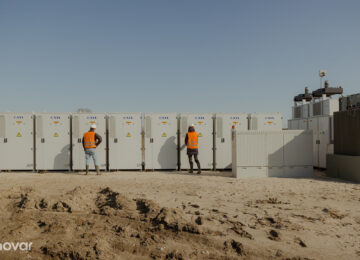Compliment of the month: DNV on LDES
In our "Compliment of the Month" series, each month we highlight a party that is is making a special effort to accelerate the implementation of energy storage. For October this compliment goes to DNV, an international engineering firm with much expertise in terms of energy engineering. With a new research they bring the discussion On the development of LDES another step further.
Batteries and LDES
DNV recently released a position paper entitled ''The competitive position of long-duration storage solutions in the power system'. Earlier, DNV presented the draft version of this already at ESNL. In this report, the firm analyzes how different types of electricity storage compete with each other in an energy system based on solar and wind. With the rapid growth of solar and wind energy, the need for flexibility in the electricity system is growing rapidly, and a key question is how it can be most cost-effectively met.
Li-ion-based batteries are becoming increasingly cheaper, but at present are still mainly used for balancing energy supply and demand in the short term. They are technically best suited for fast switching with large capacities (MW), but relatively expensive to also provide long-term capacity (MWh). Storage techniques that are precisely the cheapest when providing long-term capacity, such as flow batteries, metal-air batteries and compressed air, can therefore fulfill a significant portion of the flexibility requirement - provided they are competitive. These techniques are typically called long-duration energy storage (LDES), and often have the advantage of using relatively inexpensive and readily available materials.
LDES: road to market
DNV examined Germany and Spain as sample countries for 2035. In Spain, with a solar-dominated system, the agency concludes that 2-hour batteries in particular will be cost-effective, while Germany, with more wind, needs a mix of 2-hour and 4-hour batteries. Despite being designed for a limited number of hours, DNV expects that in practice they will be charged or discharged (at lower power) for up to 18 hours. As a result, a larger portion of the flexibility requirement could be met by batteries than previously thought.
That does not mean, however, that there is no market left for LDES. LDES technologies certainly have potential as well, but they need to drop seriously in cost to become competitive. DNV estimates that LDES technologies, which typically have lower efficiencies, will need to cost between €15 and €25 per installed kWh by 2035 to gain market share. In doing so, DNV also emphasizes that it is crucial that LDES technologies find a clear niche, where the advantage of being able to (dis)charge at maximum power for long periods of time is so important that Li-ion batteries (and industrial demand-side management) are economically less interesting.
And now: choices for flexibility
With this study, DNV brings more focus to the discussion on how to fulfill our flexibility needs. The battery market will fulfill an important part, but if we also want the benefits of LDES to come into their own, two things need to happen:
- accelerate the technical development of LDES, and
- ensure that policies are in place to address the growing need for long-term flexibility - for example, with a sustainable capacity mechanism.
DNV's new insights help inform policy choices, and so the publication of this own independent research is to be highly commended.
Latest News
 News
News
Compliment of the month: European Commission sees storage capacity grow to 171 GW
November 27, 2025 News
News
Energy Storage NL asks House of Representatives to take concrete steps against grid congestion
November 27, 2025 News
News


